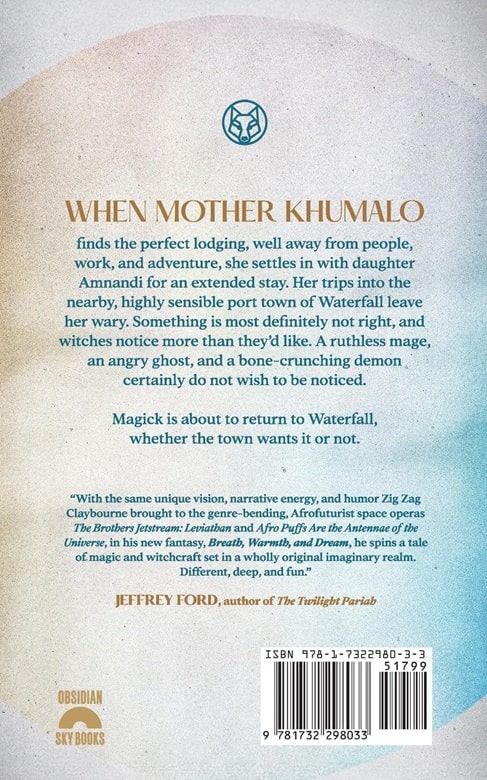A Land Two Stars to the Left of Middle-Earth: Breath Warmth & Dream by Zig Zag Claybourne
 |
 |
Breath, Warmth, and Dream (Obsidian Sky Books, May 17, 2024). Cover uncredited
In the land of Eurola, an ancient evil preyed on the people of Waterfall. Then along came Khumalo, Amnandi, and Bog – a mother daughter pair of witches and their warrior companion – to set things right. Plotwise, it’s damn near a western. If someone were to tell you that this was the whole story of Breath Warmth & Dream, that someone would be a thief. They tried to give you a penny while palming the mountain of gold.
It starts with the characters. Read Breath Warmth & Dream and your understanding of the word “witch” will be forever changed. Mother Khumalo and her daughter Amnandi are the kinds of people you want to grow up to be, even if growing up means becoming a child again. They aren’t perfect by any means because that would be boring and Zig Zag simply doesn’t do boring. It’s an imperfect and dangerous world and they make decisions without the foresight of plot armor.
But Zig Zag plays a beautiful trick. Without actually saying it, the reader understands this novel is medicinal. At the same time, when the characters are in mortal danger, he makes you forget this. You wonder if Khumalo’s goodness will be her undoing. Can Amnandi’s friendship and Bog’s love really survive an encounter with ancient beasts, and the even older ugliness of people confronted by an outsider?
It’s a short book. You could read it in a day. But trust me, you’re going to want to slow down and savor it. There are going to be scenes that you read again, if only to have the pleasure of the words passing through your lips, the image flowing through your mind’s eye and returning like the tide:
In [Khumalo’s] mind, Eurolan [m]agic –lacking the weight of her language’s harder, respectful edge to the word…was too often meant to take something, very rarely to give.
Magick, however…
You reread Breath Warmth & Dream not just to relive the poetry and wordplay, but the poetics and worldplay. Sometimes a sentence triggers such a cascade of ideas, it forces you to stop and wonder at just how much this world has expanded (When you meet the ravens, you will understand). In this land two stars to the left of Middle-Earth, you get the feeling that it goes on forever over the edge of the map. Yet somehow, if you started adventuring in one direction, you would eventually find your way home. Magick.
Yes, there is action. There are real monsters doing truly monstrous things. The story starts with the vampiric Twitswaddle biting off more than he can chew. He has a hilarious moment of introspection:
[Twitswaddle] felt the sure power inside [Khumalo’s] frame and the imaginative energies within her skull and wondered–very quickly, so that he could easily dismiss it – had he misjudged that ability to handle?
In the voice of Morgan Freeman, “Yes, dear reader, he did in fact misjudge.” But the story unwinds and Zig Zag shows you exactly how powerful Twitswaddle is and how lucky Khumalo had been that he underestimated her. The danger builds and evil calls to even greater evil. When the MCU fight comes, buckle up. You’ll be glad that this is a book, so that you can turn the page and read it again. But it’s not a story driven wild by a chain of fight scenes. It’s a story about healthy decisions.
Zig Zag is also an independent author and it shows. I can see the places where an agent or editor might have suggested to speed up, slow down, add more salt, add more pepper, add more sugar, add more spice, ad nauseam. Maybe change the title to The City of Bone Grinders and Witches. The story would not be better for it.
Genre savvy readers like myself have read/watched enough cook-by-committee stories that we have internalized plot points and expectations that, for better or worse (worse now with the inception of A.I into the writing process), have carved deep grooves in our brains; this is how a story should be. But Breath Warmth & Dream sees those well-worn canal-pits and says, nah, you need a new experience.
When I was about halfway through Breath Warmth & Dream, I lost the book. Two days later, it mysteriously appeared in my two-year-old’s’ bedroom. But when I didn’t know where it was, I was actually upset. Reading this book had become part of a nightly ritual I hadn’t completed. Well, now I have and the ending, which is really another beginning since there are two more books planned in the trilogy, is beautiful. It’s exactly what it needs to be: about the future facing love of mother and daughter. The cumulative effect of every person who experiences that ending makes our world that much better. We could all use more breath, warmth, and dream.
Sounds like a good read!
Splendid review.